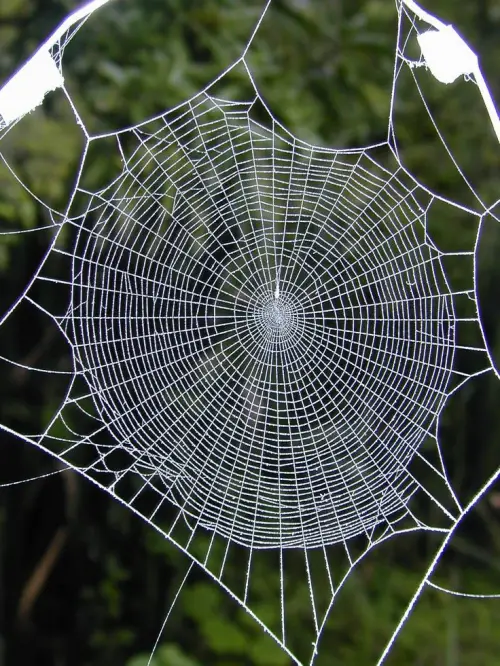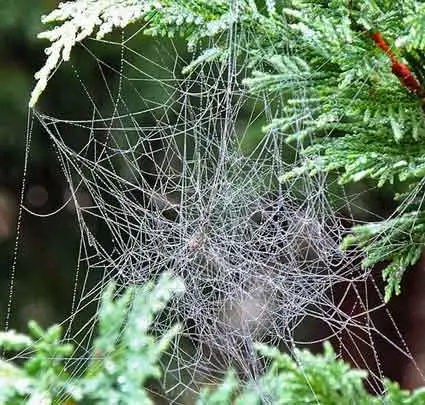Do you have a major fear of spiders? If so, you’re not alone! Many people are afraid of these eight-legged creatures we often share our homes with. There are also people who love arachnids! No matter which category you fall into, you may be interested in learning the difference between a spider web and a cobweb.
Many people think that a spider web and a cobweb are exactly the same. However, this is actually a misconception. If you are one of the many who do not know what sets the two terms apart, this article is for you. In this article, we will explain why a spider web and a cobweb are different.
Summary Table
| Spider Web | Cobweb |
| A net-like structure built by spiders; made of silk threads from the spider’s spinneret glands | A kind of three-dimensional spider web that is specifically created by cobweb spiders or comb-footed spiders; also called “tangle web” because it looks like tangled silken threads |
| Refers to webs that are currently being used by spiders or those that are not abandoned | Also refers to the abandoned spider webs that have collected dirt and dust |
Descriptions

A spider web, also called “spider’s web” and alternatively spelled “spiderweb,” is a net-like construction built by spiders.
Spiders use spider webs to trap their prey so they do not have to exert a lot of energy chasing down insects. They also use their webs to protect themselves and their eggs from predators such as large insects and birds.
The most common types of spider webs are:
- Sheet webs
- Funnel webs
- Tangle webs or cobwebs
- Tubular webs
- Spiral orb webs
Spiders use their spinneret gland, a tiny tubular appendage located in the upper part of their abdomen, to produce the silk needed for the construction of the web. Depending on the species, a spider can have four to six spinnerets, with each spinneret capable of producing different kinds of silk for different uses. For instance, a spinneret can produce sticky silk beneficial for trapping insects or a strong, fine thread to encase it.
The silk used in spider webs is made of protein fiber and is stored as a fluid which then hardens upon exposure to air. The strands of a spider web tend to be strong, thin, and sticky. The silk strands created by spiders use a special glue and proteins naturally created by the spider’s body.
Because spiders use a lot of energy to produce the silk thread for their web, some species of spiders eat their own web to regain their energy.
Spider web strands are usually bluish or white in color; however, in the moonlight or sunlight, spider webs can “change” colors.
Many centuries ago, spider webs were used as wound pads to stop bleeding. Because they contain a high amount of vitamin K, they aid in clotting blood.
Spider webs are commonly found outside in trees and bushes. However, they’re also found inside your home. Some spiders tear their webs down every day and rebuild them at night. So, it’s not uncommon to walk through a spider web in the early morning that wasn’t there the night before!

The word cobweb is derived from the old English term “coppe” which means “spider.” It is a kind of spider web that is built specifically by cobweb spiders or comb-footed spiders belonging to the Theridiidae family.
Cobweb spiders have the unique ability to build three-dimensional web architectures which sometimes look tangled (thus, the term tangled web). Like the other kinds of spider webs, a cobweb is primarily used to trap insects for food and for protection.
In more colloquial usage, the term “cobweb” is also used to refer to webs that have collected dust and dirt or a spider web that has been abandoned or no longer used by spiders.
Cobwebs are typically made by house spiders or are abandoned webs. These are more often found in the house. House spiders generally choose dark areas that aren’t disturbed. You may find cobwebs on windowsills, in corners, in bathrooms, and more.
Cobweb strands are more flimsy. While they are made of silk, cobwebs don’t use the same protein to create the strands. They use a different type of silk compared to spider webs.
In the 16th century in the Austrian Tyrolean Alps, cobwebs were wound and then layered to create a fabric which artists used for painting. These “cobweb paintings” were created by applying color and making engravings to the cobwebs. Centuries ago, cobwebs were also used to heal cuts and wounds quickly.
Spider Web vs Cobweb
What, then, is the difference between a spider web and a cobweb?
A spider web is a general term that refers to the net-like structure made of proteinaceous silk from the spinneret glands of the spiders.
Spider webs are designed to catch insects and other small animals that enter into them for food or shelter. Aside from its purpose to catch prey, spiders build webs to protect these arthropods from their predators by luring them into their deadly traps.
Spider webs are made up of spider silk strands that are strengthened by threads which are built into them with the use of glue or proteins. It is one of the strongest natural fibers known to man as it is stronger than steel. The strength of these dragline silks can be measured in terms of tensile strength, which is measured in pounds per square inch.
Spider webs are built by family of spiders like family Araneidae (also known as the orb-weaver spiders), Nephilidae, Tetragnathidae, Agelenidae, Uloboridae and others.
A cobweb, on the other hand, is a type of three-dimensional or “tangled” spider web which is specifically built by cobweb spiders or comb-footed spiders. The differences in silk produced by the two different species cause variations between webs and cobwebs.
Additionally, the term “cobweb” also refers to abandoned spider webs that have collected dirt and dust. A spider from family theridiidae and linyphiidae (such as money spiders) intentionally builds cobwebs.
How Are Cobwebs Created?
Cobwebs are tiny web-like structures built by the cob (another word for spider) and grown in an area of high humidity. The fact that they grow in such a place is surprising because they normally live in places with low humidity. They often form when high humidity accumulates in a small area and can also form in areas where there is no airflow, such as closets and cabinets. They may also form when humidity rises due to wet towels or clothes drying on a clothesline. When the humidity rises enough to allow the cobwebs to form, they quickly spread throughout the area and grow larger and larger until the area becomes completely covered with cobwebs. Cobwebs can be created anywhere where water vapor accumulates, such as shower stalls, sinks, basements, attics, etc.
Cobwebs are often found in areas where there is no airflow because there is no wind blowing through them or at least not enough wind blowing through them to blow away their small dust-like component that has been suspended in the air. If the air in an area is still, the dust-like component is able to combine with other airborne particles and grow into cobwebs.
Cobweb strands come in a wide variety of colors, including white, brown, gray, and black.
Why do I have so many cobwebs in my home?
Cobwebs can be an indication that you have a spider problem in your home. Cobwebs are either abandoned spider webs or webs by house spider species.
However, if you clean up the cobwebs by vacuuming or dusting and they reappear, then your home definitely has a spider problem. You may want to consider using natural spider repellents you can make at home or calling a pest control service to get rid of the spiders in your home.
What can you do to prevent cobwebs from forming?
There are many things to prevent cobwebs from forming so that your home won’t look like that you started decorating for Halloween early. These methods include to: use a dehumidifier; use a fan; remove wet towels from clotheslines; open windows and doors during dry weather; clean your house often; clean carpets often; dry clothes indoors if possible; remove moist objects such as damp towels from a clothesline when possible; keep pets out of damp areas such as basements and closets because pets do not like dampness or cobwebs; and use a clothesline if you have to hang wet clothes outside.
How do you remove cobwebs?
Cobwebs can be removed by using a vacuum cleaner to suck up the cobwebs and dust-like particles that they have collected in the air. You can also remove cobwebs by sweeping them up or vacuuming them up with a vacuum cleaner. Another way to remove cobwebs is to use a dehumidifier to reduce the humidity in an area. A dehumidifier will remove the moisture from the air and this will reduce the number of dust-like particles that can combine with other airborne particles and grow into cobwebs. If you cannot use a dehumidifier, you may want to open windows and doors during dry weather and allow fresh air into an area which will prevent dust-like particles from accumulating on surfaces such as carpeting or clothing which then will not combine with other airborne particles and grow into cobwebs. Another way to reduce humidity levels is by using fans during dry weather to blow away any moisture that may accumulate on surfaces such as carpets or clothing, which then will not combine with other airborne particles and grow into cobwebs.
Differences Between Spider Web and the Cobweb: What Does Each One Look Like?
Spiders create beautiful web designs with great detail, which look very impressive when they weave their webs in the sunlight or at night under moonlight. These amazing designs look very detailed with several colors used in order to create a very impressive and attractive website. They use these webs to catch insects and small animals like flies and spiders themselves.
However, if you were to take a look at a cobweb, you would see that it is made up of small pieces of silk which are stuck together in the shape of a circle or even irregular shapes. It can also be different colors, such as white, brown, gray or black depending on the type of animal that made it.
You may also notice that the cobwebs may have a hole in the middle where they attach to a surface. However, this is not always the case as some cobwebs may not have any holes at all. In order to make them stick better to surfaces or walls, they often have a glue on the inside which helps them stay there without being easily removed by hand or tools like vacuum cleaners.
Conclusion
Cobweb and spider web are both different in appearance and their functions. A spider web is very thin, strong and sticky, whereas a cobweb is thick, delicate and flimsy. Spider webs are used to entangle prey and can be spun into traps for other creatures.





